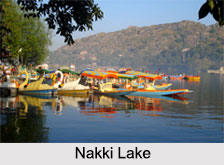 Nakki Lake is a delight for nature enthusiasts. The lake in itself is regarded half a mile in span and quarter of a mile in breadth. Mahatma Gandhi"s ashes were engrossed in this sacred lake on 12th February 1948 and Gandhi Ghat was created. Nakki Lake is a major tourist attraction. The lake is picturesquely set amidst hills. Nakki Lake is dotted with small islets and is the only lake in India that is located at an altitude of 1200 m above mean sea level.
Nakki Lake is a delight for nature enthusiasts. The lake in itself is regarded half a mile in span and quarter of a mile in breadth. Mahatma Gandhi"s ashes were engrossed in this sacred lake on 12th February 1948 and Gandhi Ghat was created. Nakki Lake is a major tourist attraction. The lake is picturesquely set amidst hills. Nakki Lake is dotted with small islets and is the only lake in India that is located at an altitude of 1200 m above mean sea level.
Location of Nakki Lake
Nakki Lake is situated in the beautiful Indian hill station of Mount Abu in the Aravalli range.
Geography of Nakki Lake
Nakki Lake is in span of a half mile and in width about of a quarter of mile and 20 to 30 ft. deep towards the dam on the west. There is the Toad Rock on a hill close to the lake.
Legends of Nakki Lake
Nakki Lake the mythological lake with a very interesting story behind its creation is the heart of Mount Abu. Legends say that Gods carved out Nakki Lake with their nails for protection against the oppressions of Bashkali, a wicked demon. The lake got its name as "Nakki Lake" because it was dug out from nails.
While another legend is of Rasiya Balam, who dug the lake, as the king told that whoever will dug the lake within one night will marry his daughter. But later king"s wife refused and he could not marry the king"s daughter. Temple of Rasiya Balam and Kunwari Kanya, king"s daughter is located behind the Dilwara Jain Temple.
Places of Interest around Nakki Lake
The lake offers boating facilities and horse rides around the lake. Sri Raghunathji Temple and Maharaja Jaipur Palace are located near the lake. The green hills near the lake, date-palms and Gandhi Ghat garden enhance its beauty. The surrounding hills have several areas of interest. Recently in 2006-2007 Nakki lake was granted a huge financial boost for its protection amongst 8 other lakes in India.
By the side of the lake, there is a pathway leading to Sunset Point. It is prohibited to go up to Sunset Point due to risky bandits living around the path to Sunset Point. A festival is held in in the month of Shukla Paksha in April by the local people to worship and memorize ancestors, and sanctify their nails.
Visiting information of Nakki Lake
Nakki Lake is in a walking distance from the main market of Mount Abu. People can take a cab to reach here. Regular buses are also available. Nearest airport is the Udaipur Airport.















